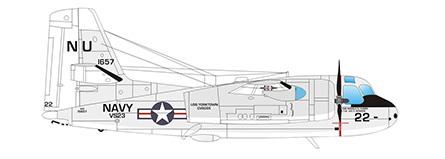Enjoy free admission year-round, plus other great perks!
S-2E Tracker
Statistics for S-2E Tracker
type
Twin-engined Anti Submarine Warfare Aircraft
bureau number
151627
nmna id
2005.074.001
manufacturer
Grumman
powerplant
Two 1137-kW (1525-hp) Wright R-1820-82 or -82A radial piston engines
maximum speed
451 km/h (280 mph) at 1220 m (4000 ft)
climb rate
594 m/min (1950 fpm)
cruising speed
269 km/h (167 mph)
range
1785 km (1105 miles)
service ceiling
7560 m (24,800 ft)
Armament
2181 kg (4800 lbs) of depth charges, torpedoes, or rockets
weights
Empty 7544 kg (16,600 lb) Maximum take-‐off 11,158 kg (24,548 lb)
dimensions
Span 21.23 m (69 ft 8 in) Length 12.80 m (42 ft) Height 4.97 m (156 ft 4 in) Wing Area 45.06 m2 (485 sq ft)
Introduced in 1954, the S-2E Tracker was designed to find, follow, and if necessary, kill enemy submarines. Spanning three decades, the primary purpose of the S-2 was to be a thorn in the side of Soviet submarines. Originally designated the S-2F-1, it didn't take long for Tracker crews to come up with the nickname STOOF (as in S-2-F).
A fixture on Essex class carriers like USS Yorktown, the S-2 expanded sub hunting to the open ocean in ways land based brethren like the P-3 Orion could not. The S-2 could turn into an offensive weapon, armed with a combination of torpedoes, rockets, mines and depth charges.







